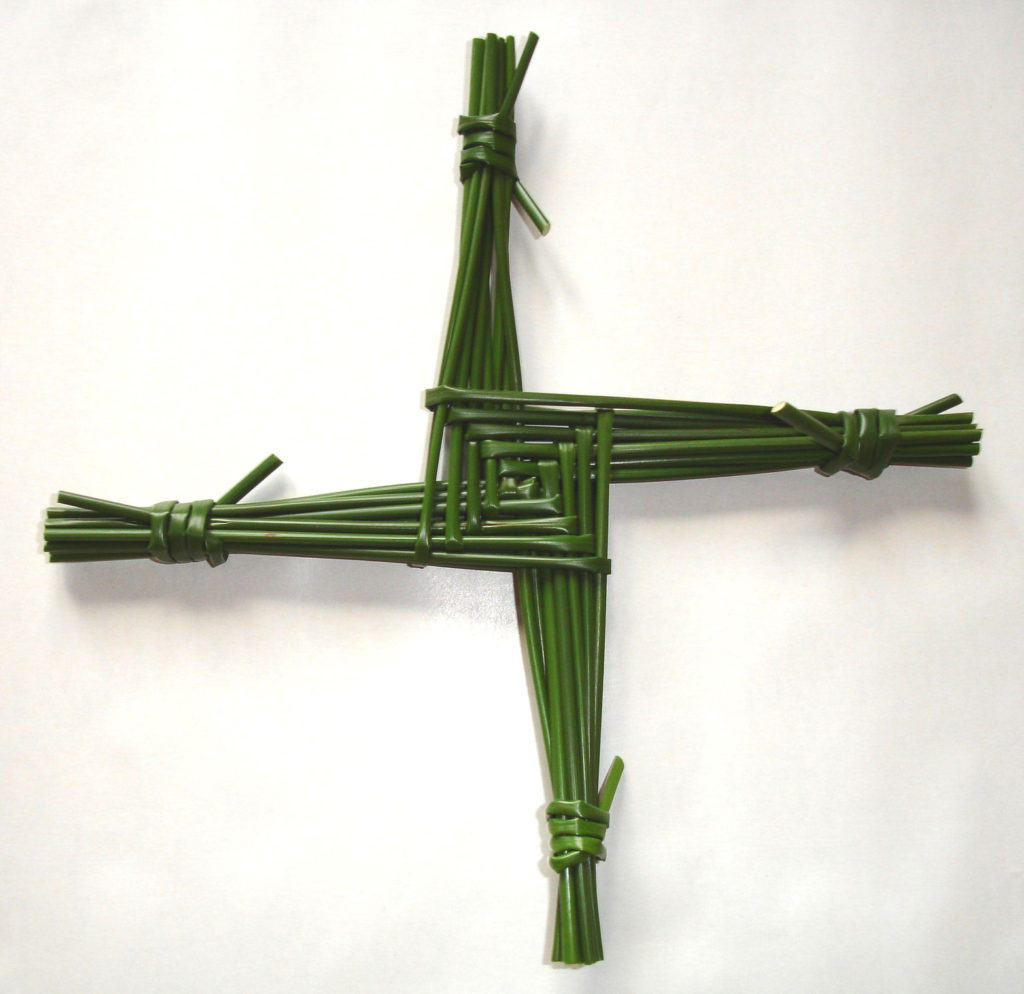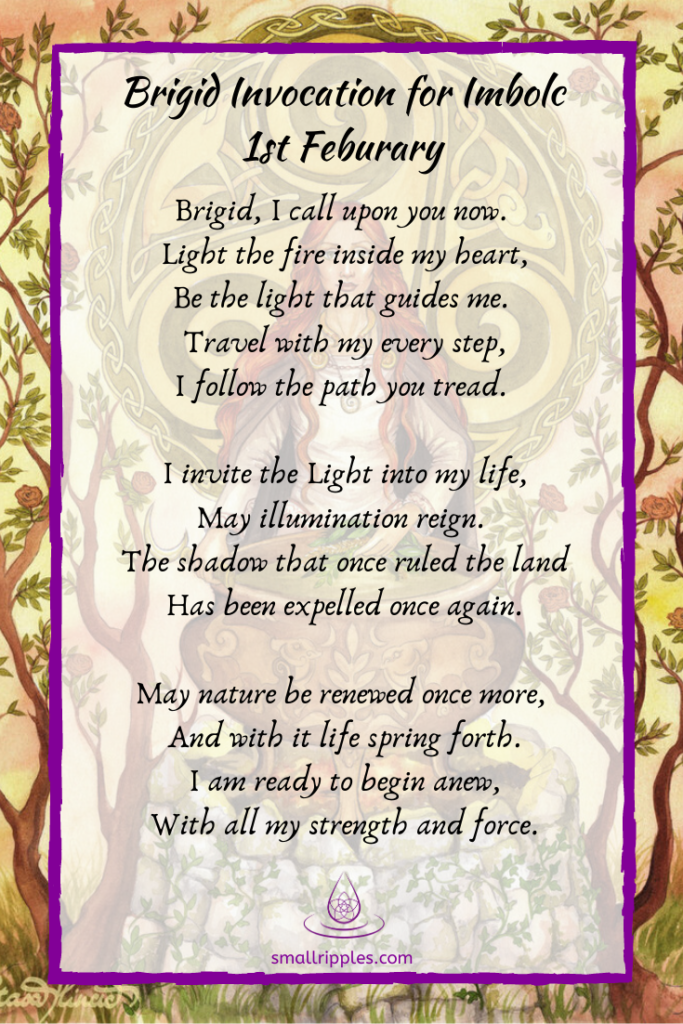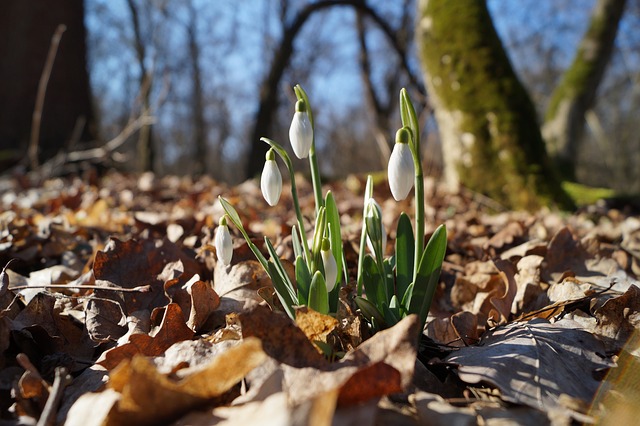January draws to a close – the days are becoming longer, the sun is getting stronger and the first flowers of spring can be seen on the still frosty ground. These are the signs that Imbolc (pronounced ‘Im-ulk’) is here, an ancient Celtic festival that marked the beginning of spring and celebrated the return of longer and lighter days.
Imbolc was usually celebrated in the first week of February, halfway between the winter solstice and spring equinox. It is one of four major Celtic fire festivals that were celebrated throughout the year along with Lughnasadh, Beltane, and Samhain.
The Goddess Brigid is the deity that reigned over Imbolc where she would travel across the land bringing warmth and breathing life back into nature. In Celtic times, she was considered a goddess of fertility, poetry, healing, smithcraft, sun and fire but many centuries later she was remodelled as a saint. The festival was later Christianised and celebrated as Saint Brigid’s Day on 1st February and was historically observed in Ireland, the Isle of Man and parts of Scotland.
Contents
What is Imbolc?: The Origins of Imbolc
Very little is known about the origins of Imbolc or what the festival entailed in ancient Celtic times. We do know, however, that the festival must have been greatly important to the Celts as the passageway of the ancient megalithic monument the Mound of the Hostages, illuminates at sunrise on both Imbolc and, significantly, Samhain as well.
In the same way that Samhain would celebrate and welcome the onset of darkness and cold, Imbolc celebrated the return of light and warmth. In many ways, Imbolc can be seen as an inversion of Samhain. Imbolc was a time when nature would begin to wake up from the long sleep of winter and soon the land would become ripe for hearty crops to grow again.
This time of year was also the start of the lambing season and usually, the Celts knew that the promise of spring was upon them when the ewes would begin to lactate. Many have even translated Imbolc, or Imbolg and Óimelc as it is also known, to mean ‘ewe’s milk’. However, historians and linguists debate the exact translation of the word with some translating it to mean ‘in the belly’.
Ronald Hutton explains in his book The Stations of the Sun: A History of the Ritual Year in Britain that there definitely seems to be some connection with the Old Irish word for milk and that the former translation is more likely to be correct. Significantly, Eric Hamp has suggested that the Old Irish words for ‘milk’ and ‘milking’ were derived from a lost Indo-European word for purification or cleansing. And indeed, that does seem to be one of the key themes of Imbolc for the darkness and decay of winter had been washed away, ready for life to return to the land.
Courtney Weber describes the true essence of Imbolc in Brigid: History, Mystery and Magick of the Celtic Goddess: “Although the ground was cold and often snow still present, the first stirrings of spring arrived with Imbolc, and with them, the promise of health, food, and life restored again.”
And with this renewal of life and fertility came Brigid, the goddess of fire who brought warmth and the youth of spring.
Looking for tools to help you easily celebrate Imbolc and the other Wheel of the Year sabbats?
Discover the Wheel of the Year Bundle which contains:
- Ritual planners
- Celebration planner pages
- Correspondence pages
- Card spread guides for all 8 sabbats
- Full and New Moon Planner
Get 15% off by using the code BLOG15
>>Get your copy here<<
Brigid the Celtic Goddess and Giver of Life
We cannot talk about Imbolc without talking about Brigid. She is the symbol that represents the magic of this time year and her image has become bound to Imbolc through the celebrations of St Brigid’s Day. Her varying forms over the years are imperative to understanding who she is. As a goddess, she was considered a tutelary (protector) deity: a friend of poets and smithcrafts but also of expectant mothers. As a saint, her feminine graces were more emphasised as she was thought to be a friend to animals and children.
Courtney Weber sums up her varying images quite nicely:
“the goddess of forge and anvil, of poets, painters and prophets. She is a goddess of healing as well as battle, of fire but also water, of love and death. She blesses small animals, guards orphaned children, and challenges authority. She has crossed the chasm of regional land goddess to Christian saint and back again to a contemporary Goddess of a global scope. Distinct as the multitude of tongues that speak her name, and deeply rooted in creation, destruction, regeneration, and sometimes contradiction – this is Brigid.”
Little is known about her as a Celtic goddess but she is thought to be linked to the Pre-Roman British goddess Brigantia and has often been compared to the Roman goddess Minerva, goddess of wisdom, war, and skills.
One tenth-century Irish scholar recorded that “Brigid, that is, the female poet, daughter of the Dagda. This is Brigit the female seer, or woman of insight, i.e. the goddess who poets used to worship, for her cult was very great and very splendid.”
From Celtic Goddess to Catholic Saint
When Christianity came to Ireland the goddess Brigid eventually became Christianised and was subsequently made into a saint. Both goddess and saint share many of the same attributes but, as I mentioned before, with a differing emphasis placed on various attributes.
One thing is for sure and that is that Brigid in her form as a saint was every bit as adored and venerated as the goddess Brigid. To this day, she is considered the mother saint of Ireland and there are many sacred sites that she is associated with along with many wells.
“She who put beam in moon and sun,
Traditional Irish Prayer and Invocation For Imbolc
She who put food in earth and herd,
She who put fish in stream and sea,
Hasten the butter up to me.
Pray Brigid, see my children yonder,
Waiting for buttered buns,
White and Yellow”
In the monastery of Kildare, Brigid’s strongest place of worship, the nuns lit a fire in her honour that lasted for 600 years. It has been suggested, in fact, that her survival and unbroken worship is due to her changeover to a saint, for, without it, it is likely that her name would have become myth and legend.
The feast of Saint Brigid’s Day that takes place upon the old Celtic festival of Imbolc, is what really ties her magic to this time of year. On this day, many festivities and rituals would have taken place. One of the most common practices was to set out food and possibly a bed for Bride (as she was also known) as she passed by and blessed virtuous households.
Another common practice was to place a críosog Bridghe, a Saint Brigid’s cross that was made from woven rushes, outside the door or even in the barn to bless the animals. A small doll made from straw, made to represent Brigid, would also be carried around by children, women and young men. This was known as a Breedhoge, Brídeóg, or Biddy and was meant to bring luck.

Image Credit: Wikimedia
Imbolc Rituals and Ideas For Celebrating this Day
Imbolc is a wonderful time of year for sowing seeds of potential, starting new projects, and kick-starting a new cycle. It is the time to think about doing a ‘spring clean’ of your life and choosing what you want to keep and what you want to discard. For the Celts, the rebirth and regeneration of nature at Imbolc would have meant the beginning of a new cycle. If you are choosing to celebrate Imbolc, it is a good idea to keep this in mind and implement this theme in the way that you choose to celebrate it.
Imbolc Ritual
Planting Seeds On Imbolc: Ritual for new beginnings, new projects, and abundance.
This is an incredibly simple ritual that connects you to the natural power of this time of year. Its magic lies in the symbolism of planting and sowing seeds as this is the ultimate symbol of new beginnings.
What you will need:
- seeds
- pot of earth
- Jug of water
- A trowel
Take the seeds and dig a hole in the earth, plant them accordingly (check the packet to see correct spacing or look online).
Before you cover them with the earth, say these words:
I welcome the return of light and the warmth of the sun.
I plant now the seeds of my success and prosperity.
From these seeds spring a new beginning and chapter for me.
I vow to nourish this new beginning, giving it all the sustenance that it will need.
Cover the seeds with earth and drench with water.
As the flower or plant grows, as will your new venture or project so make sure to care for this plant.
Ritual for Brigid: Connecting with her Light
This is a wonderful ritual for anyone who is asking for inspiration from Brigid.
What you will need:
- A space that has clear energy. This could be an altar decorated with items related to Imbolc or just a tidy quiet area of a room.
- 3 candles: 1 White, 1 Orange, 1 Green
The white candle is to represent purity and the maiden aspect of spring, the orange candle is to represent the sun and fire of Brigid and the green candle is to represent the return of greenery. I have chosen three candles specifically as Brigid is a triple goddess. If you don’t have these colour candles, that doesn’t mean you can’t perform the ritual. Just use three of whichever colour candles you have. The most important point is the intention.
Light the three candles whilst saying this invocation:
Brigid, I call upon you now.
Light the fire inside my heart.
Be the light that guides me.
Travel with my every step
I follow the path you tread.
I invite the Light into my life,
May illumination reign.
The shadow that once ruled the land
Has been expelled once again.
May nature be renewed once more
And with it life spring forth
I am ready to begin anew
With all my strength and force

Some other ways you can celebrate Imbolc
- Make a St Brigid’s Cross – You can find instructions how to make one here.
- Make a Bridey Doll – Here is how to make one
- Connect with nature by planting seeds that are in season –
This could be different from the seed-planting ritual above and just a beautiful way to connect with nature. Sow Antirrhinums (Snapdragons) and Laurentia now to ensure early flowering. Plant begonia tubers (hollow side up) in pots of moist compost and just cover with a little more compost. Keep them in a bright, frost free position. If you would like to plant vegetables, onions, leeks, lettuce, garlic and shallots can all be sown at this time of year too.
- Create a new project – This could be anything from starting a business to doing something creative like making a scrap book. It is really up to you how big or small this new project might be.
- Do something to honour Brigid – This could be calling upon her or doing any of the rituals or creative activities listed above or perhaps something else entirely!
This is a Magical Time of Year
Whichever way you choose to rejoice in this time of Imbolc, remember that this is a magical time of year. We are upon a new cycle of life and cheerful bright days lie ahead in the magic of spring.
What I really love about Imbolc is the feeling of this time of year. It is like a stirring in my stomach of exciting times ahead. The light is returning and with it, nature is slowly starting to wake up.
My own celebrations of Imbolc will include spending time in nature absorbing the magical feeling that it brings and preparing the garden to start growing vegetables. I will be thinking about the ways that the Celts would have celebrated it and what it would have truly meant for them.
As a society, we have become very cut off from the cycles of nature with the changes that it experiences being very underappreciated in our modern-day and age. As such, this year I wish to honour these changes and rejoice in the return of light and rebirth of nature just as the ancient Celts would have.
(214)


